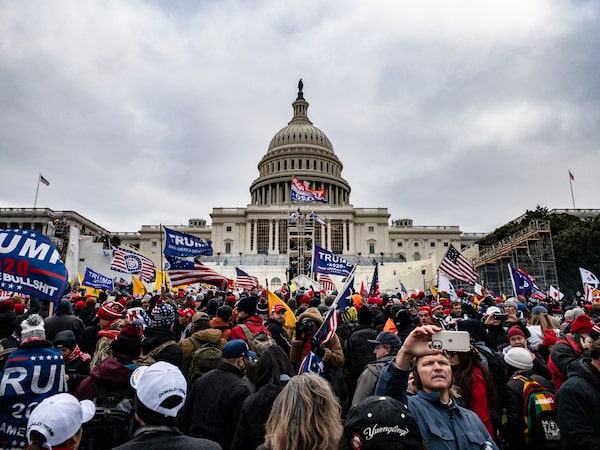
Pro-Trump supporters storm the U.S. Capitol on Jan. 6, 2021 in Washington, DC.Samuel Corum/Getty Images
Hours after a reckoning, truth was still taking a beating in U.S. politics.
Who stormed the Capitol and broke into the Congress? Antifa, suggested Laura Ingraham, the Fox News host. Rudy Giuliani, President Donald Trump’s personal lawyer, suggested the same thing: It was lefties, not Trumpists.
NBC News calculated Wednesday evening that already 7,000 accounts had posted tweets claiming antifa protesters “posing” as Mr. Trump’s supporters had been behind the violence. Congressman Matt Gaetz, Republican of Florida, used his time on the floor of the House of Representatives to advance those conspiracy theories.
The plain evidence was there. Mr. Trump had ginned up the crowd himself before the attack. So had Mr. Giuliani. Then they stormed the Capitol. There’s no evidence of antifa agitators, but Heaven knows if there were a few, they didn’t need to do any actual agitating.
The crowd was fuelled by a feeling of righteousness, believing falsely that they were there to rectify what they saw as a stolen election. That lie wasn’t just spread by Mr. Trump. It was spread by a lot of people.
After Wednesday’s riot, there were some chastened faces. Oklahoma Senator James Lankford, a picture of regret, withdrew his objection to the election result, saying he wanted to raise concerns, but not this way. South Carolina Senator Lindsey Graham, more disingenuously, belatedly noted the many courts that had ruled against Mr. Trump’s election appeals.
There was a sense that some Trump allies realized they’d help build this fire, and were shrinking back after they had been burned. But there are still people who want to wield the fire of disinformation. Will their own partisans – their own political allies and their supporters – fight it next time?
That’s a democratic problem that will last beyond Mr. Trump’s next 12 days, will reach beyond the United States, and isn’t the reserve of right or left.
More than one astonishing thing happened Wednesday. One was a president of the United States exhorting a mob to storm Congress. Another was that the mob did it. A third was that some large number of Americans, probably millions, believed it was justified. The disinformation worked.
So you have to think people will keep trying it. After Mr. Trump. Either on the right or the left.
There’s no compelling reason why it would be confined to the U.S., either, and never creep into a quiet country like Canada. At the U.S. Capitol on Wednesday, a correspondent for Canadian website The Rebel was tweeting appreciatively about the crowd, claiming the presidency was stolen and soliciting donations over Twitter. The chaotic opinionizing of social media is staying with us in some form, too, because free speech demands it. It would be nice to think, again, that democracy thrives on free speech.
What we should learn from Mr. Trump’s tenure is that the duty of a democrat, of politicians and partisans, is to fight disinformation first and foremost from their own political tribe – the things that go beyond political spin and policy disputes into ginning up outrage and a sense of moral certainty with conspiracy theories and lies. Citizens had better start judging them on how dutiful they are.
American political polarization, and its mistrust, helped Mr. Trump promote his unreality. But it could never have succeeded without disinformation propagated by others. Not just political differences, but the embrace of lies and conspiracy theories, which he took up with the birthers, fed against opponents, and fuelled in office. He pushed the notion of a Deep State inside government conspiring against him and winked at messianic QAnon crackpottery. The believers came to the Capitol.
For months, Mr. Trump had primed the pump for claims of a stolen election. His opponents and many in the U.S. media decried it, but many of Mr. Trump’s supporters were out of earshot. They didn’t believe it when they heard it. Only Mr. Trump’s political tribe, in this case the Republican Party, could have reached some of them. Some were partisan enough to fight for their side and disregard the dangerous excess. Many didn’t want to criticize their own side. Or cross Mr. Trump. Or his base.
On Thursday, some of those folks were looking like they’d seen a monster, up close. The people like Mr. Gaetz who suggested it maybe didn’t really happen seemed to be outnumbered. But the disinformation monster showed us just how vulnerable a strong democracy can be, and it hasn’t gone away.
Know what is happening in the halls of power with the day’s top political headlines and commentary as selected by Globe editors (subscribers only). Sign up today.
 Campbell Clark
Campbell Clark